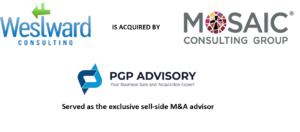PGP Advisory’s Software Implementation Client- Westward Consulting- Completes Sale

PGP Advisory, a leading mergers and acquisition advisory practice and San Antonio business broker, is pleased to announce that it served as the exclusive M&A advisor to Westward Consulting LLC, a strategic Ultimate Kronos Group workforce software implementation partner, in its sale to Mosaic Consulting Group on July 1. With this acquisition, Mosaic Consulting Group, a long-time Ultimate Software partner focused on human capital management (HCM) support and service, is adding Westward Consulting’s Kronos experience and focus on workforce management, to their services.
“We worked with John West, Founder and CEO of Westward, over the past few years to prepare his company for this significant milestone. The cultural fit of the combined organization paired with enhanced solutions offerings into the marketplace position Mosaic to create and deliver increased value to its clients, employees, and partners.” Jason Brown, Managing Partner, PGP Advisory
John West, Westward CEO adds, “This is an exciting time. Two best-in-class teams are coming together to offer a full suite of services to our clients. Now, we will be able to help our clients seamlessly optimize and hone their team related strategy, processes and technologies”
Westward Consulting was founded in 2015 as a workforce consulting company with a mission that guides organizations to exceptional workforce performance. The Westward team exemplifies their team’s values: Family, Ethical, Fun and Generous. They deliver an exceptional client experience by focusing on thinking outside the box. Finding innovative solutions for their clients is at their core.
About PGP Advisory
PGP Advisory is a M&A advisory firm that helps our clients create value in the transaction process by offering Fortune 500 experience, tools, and strategies to small and midsized businesses. We seek out, identify, and solve problems for our clients throughout the entire transaction process. We leverage both our deal and operational expertise and experience to support our clients’ desired deal outcomes.
Strategic Planning Lesson from Game of Thrones

“Fight every battle, everywhere, always, in your mind. Everyone is your enemy, everyone is your friend, every possible series of events is happening all at once. Live that way and nothing will surprise you. Everything that happens will be something that you’ve seen before.” Petyr Baelish, Game of Thrones.

Are you a “Baby Boomer” Business Owner?
What is so special about “Baby Boomer” business owners? Well, there are a lot of them. It is estimated 52 percent of businesses are owned by people between 50 and 88 years of age. This equates to 9 million businesses in the United States. Put it another way, a business owner is turning 65 every 57 seconds.
So, why is this important? Typical of most business owners, the value of their business amounts to 50 to 75 percent of their net worth (if not more); the remainder in personal real estate and financial investments. Ordinarily, the business owner has only one chance to monetize his or her largest asset through the sale of the business.
It is estimated that 11,000 people are turning 65 years old every day, with this trend continuing for the next 18 years. Being that many of these Baby Boomers are also business owners, one would suspect that every year for the next two decades more and more business owners will be wanting to sell their businesses to cash out and fund their retirements. These businesses amount to some $10 trillion worth of assets.
Yet while more and more businesses go up for sale, the audience of buyers is decreasing. Today, the highest segment of business buyers is the same Baby Boomers in the age range of 55 to 64 years old. The 80 million millennials in the U.S. make up a larger demographic, though their abilities to purchase these businesses are quite low.
Applying the law of supply and demand, there is going to be a growing inventory of businesses for sale each year, while the number of qualified buyers is decreasing each of those years. The law of supply and demand would suggest there will be pricing pressure on these businesses. In addition, overall only 1 out of 4 businesses actually sell after being put on the market; however, the success rate increases to 1 in 3 for businesses with sales of $10 million, and the sale success rate grows to 1 in 2 for businesses with sales greater than $10 million.
Now What?
The PriceWaterhouseCoopers accounting firm estimates more than 75 percent of business owners have done little planning for their single biggest financial asset. It is sad to say, but business owners spend more time planning their next vacation than planning for their exit into retirement.
Business owners should start the exit planning process today. Serious consideration should be given to creating a timeframe to place the business in the best position to be sold at the highest possible valuation.
Fortunately, the window of opportunity is quite good. Current conditions of rock bottom interest rates, low inflation, historically low capital gain taxes and overall high business valuations make this an ideal time to sell a business. In real estate it is all about “location, location, location,” whereas in business it is all about “timing, timing, timing.” Now is the time to cash in.
Exit planning, however, is a process that requires a significant amount of work. Most important, business owners need to assemble a team of professional advisors to assist them in this process. The team may consist of all or some of these professionals: a business intermediary firm, CPA/accountant, business attorney, financial planner, investment advisor, insurance advisor, valuation specialist, investment banker, banker and business consultant.
Using the analogy of an actual roadmap, this process can be broken down into five exits:
Exit 1: Making the Decision to Sell
Exit 2: Exit Planning Process
Exit 3: Maximizing Business Value
Exit 4: Preparing the Business for Sale
Exit 5: The Deal Process
The actual Planning Process often includes the following seven steps:
1. Identify Exit Objectives
2. Quantify Business & Personal Financial Resources
3. Maximize & Protect Business Value
4. Ownership Transfer to Third Parties
5. Ownership Transfer to Insiders
6. Business Continuity
7. Personal Wealth & Estate Planning
There is no time better than right now to start planning an exit, whether that is tomorrow, next month, next year or the next decade. Just be careful not to miss your EXIT…else you will hear your GPS (or significant other) say, “when possible turnaround” or as my GPS would say, “you idiot, you missed your exit…proceed on this road for another 20 miles.”
This article appeared in the November 2015 edition of Traverse City Business News.
Read More
